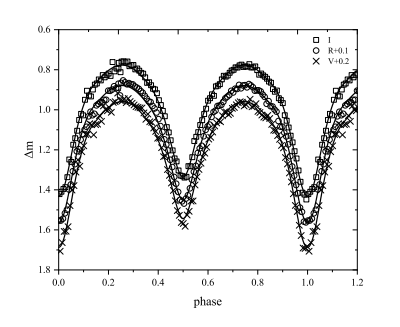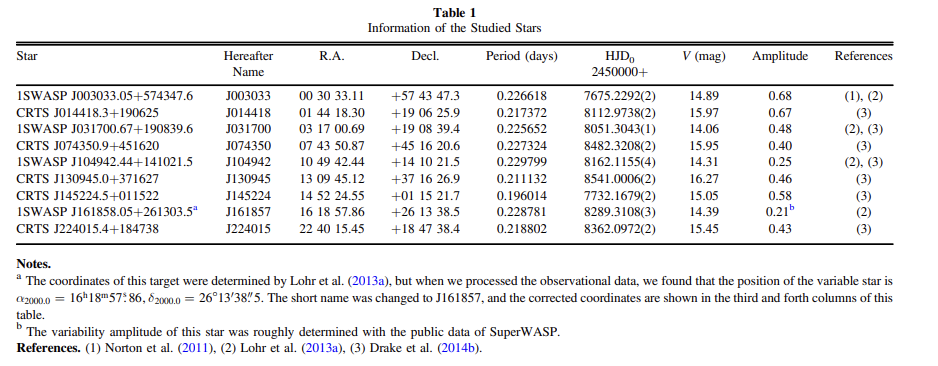¶ EW(W Ursae Majoris 变星,又称大熊座W型变星)
作者:李瑀旸
主分类:Eclipse
¶ 历史背景
W UMa型双星系统(相接双星)通常包含两颗主序星,其谱型从F到K不等。这些系统有一个共同的、包裹两颗子星的对流层,其轨道周期通常小于一天。在过去的五十年中,许多研究人员已经研究了这些双星系统[1][2][3][4][5][6],但是它们的结构和演化仍然存在一些问题,例如短周期截止问题[7][8][9][10],以及质量比下限问题[11][12][13][14]。
¶ 物理图像
¶ 基本信息
大熊W型变星是一种食双星变星,两颗星非常的靠近。因为它们外面数层的气体是共有的,因此被称为共包层双星。经由两颗星相连之处,双方的质量和热可以相互流通,会使两颗星的温度一致。大熊W型变星在现在的宇宙中非常普遍,其数量约占全部恒星的1%。
这个分类可以分为两个次分类:A型和W型[15]。构成A型的大熊W型变星的两颗星都比太阳热,光谱属于A或F型,周期在0.4至0.8天。W型的是温度较低,光谱为G或K型恒星,周期较短只有0.22至0.4天。表面温度的差别通常都少于数百K。在1978年,表面温度差异较大的新类型:B型被区分出来。在2004年,H型(高质量比系统)被Sz. Csizmadia 和 P. Klagyivik[16]发现。H型的质量比大于q=0.72(q= (伴星质量)/(主星质量)) ,并且有特别大的角动量。
¶ 光变特性
因为长期受椭球体的影响,而且不是分离的食,它们的光度曲线和其他类型的食双星不同。这不仅是因为两颗星实质的接触在一起,因而经常性的掩食;同时,也因为受到另一颗星重力的扭曲。因为两颗星的光度几乎相等,食亮度的极小值也几乎是一样的。

EW型光变曲线[17]
¶ 短周期截止问题
对于双星周期分布,存在一个大约在0.22天左右的明显突降点, Rucinski[18]声称完全对流极限可能可以解释短周期截止问题。Stepien[19][20]提出角动量损失时间尺度太长,无法形成极短周期接触双星。Jiang et al. [21]提出,主星组分质量下限约为0.63 导致短周期限制。最近,Li[22]提出,在形成一些超短周期相接双星(USPCBs1)时,第三个伴星通过从中心的掩星中,消除角动量损失以起到了重要作用。目前,短周期极限问题仍然是一个悬而未决的问题,应该观察和分析更多处于短周期截止位置的相接双星[23]。下表展示了这九个目标的基本信息。

¶ 质量比下限
根据Li[24], 理论研究提出,相接双星表现出低质量比的截止,并将由于达尔文不稳定性而合并成快速旋转的单星[25][26][27][28][29][30]。极低质量比相接双星(ELMRCBs)定义为质量比小于0.15的相接双星。目前只发现了很少的ELMRCBs,如V1187 Her(q∼0.044[31]),VSX J082700.8+462850(q∼0.055[32]),V857 Her(q∼0.065[33]),ASAS J083241+2332.4(q∼0.068[34])。统计和模拟研究表明,对于完全掩食的相接双星,光度质量比与光谱质量比是一致的[35][36][37][38]。Rucinski[39]确定了接触双星的最大振幅、质量比和接触度之间的关系,并发现振幅越小,质量比就越小。下表展示了这十个系统的基本信息。

¶ 重要文献
Adams, W.S., and Joy, A.H., 1919, "The Orbits of Three Spectroscopic Binaries ," The Astrophysical Journal, 49, 186
Binnendijk, L., 1970, "The Orbital Elements of W Ursae Majoris Systems," Vistas in Astronomy, 12, 217
Gazeas, K.D., and Niarchos, P.G., 2006, "Masses and Angular Momenta of Contact Binary Stars," Monthly Notices of the Royal Astronomical Society, 370, L29
Genet, R.M., Thomas, C.S., Terrell, D., Doyle, L., 2005, "Changes in the Light Curves of Short-Period W Ursae Majoris Binaries: Program Summary," Journal of the AAVSO, 34, 54
Guinan, E.F., and Bradstreet, D.H., 1988, Kinematic Clues to the Origin and Evolution of Low Mass Contact Binaries," in Formation and Evolution of Low Mass Stars, A.K. Dupree and M.T.V.T. Lago (eds), ASI Series, 241, 345
Hilditch, R.W., King, D.J., and McFarlane, T.M., 1988, The Evolutionary State of Contact and Near-Contact Binary Stars," Monthly Notices of the Royal Astronomical Society, 231, 341
Kopal, Z., 1955, "The Classification of Close Binary Systems," Annales d'Astrohysique, 18, 379
Kopal, Z., 1959, "Semi-Detached Binaries and Stellar Evolution," Astronomical Society of the Pacific Leaflets, 8, 81
Kuiper, G.P., 1941, "On the Interpretation of Beta Lyrae and Other Close Binaries," The Astrophysical Journal, 93, 133
Li, L., Zhang, F., Han, Z., and Jiang, D., 2007, "Formation and Evolution of W Ursae Majoris Contact Binaries," The Astrophysical Journal, 662, 596
Lucy, L.B., 1968, "The Structure of Contact Binaries," The Astrophysical Journal, 151, 1123
Muller, G., and P. Kempf, 1903, "A New Variable Star of Unusually Short Period," The Astrophysical Journal, 17, 201
Pribulla, T., and Rucinski, S.M., 2006, Contact Binaries with Additional Components. I. The Extant Data," The Astronomical Journal, 131, 2986
Rucinski, 1993, "Contact Binaries of the W UMa Type," in The Realm of Interacting Binary Stars, J. Sahade et al. (eds.), 111
Schilt, J., 1926, "Two New Variable Stars of the Type of W Ursae Majoris," The Astrophysical Journal, 64, 215
Terrell, D., 2001, "Eclipsing Binary Stars: Past, Present, and Future," Journal of the AAVSO, 30, 1
Terrell, D., 2006, "Eclipsing Binary Stars: Future Work," in Astrophysics of Variable Stars, Sterken, C. and Aerts, C. (eds), ASP Conference Series, 349, 91
Wilson, R.E., 1978, "On the A-Type W Ursae Majoris Systems," The Astrophysical Journal, 224, 885
Wilson, R.E., 2001, "Binary Star Morphology and the Name Overcontact," Information Bulletin on Variable Star, 5076, 1
Wood, D.B., 1969, "A Frontal Attack on Eclipsing Binaries," Bulletin of the American Astronomical Society, 1, 267
Van Hamme, W., 1982, "On the Evolutionary State of the W Ursae Majoris Contact Binaries," Astronomy & Astrophysics, 105, 389
Whelan, J., Mochnacki, S.W., Worden, S.P., 1974, "W Ursae Majoris: Mass-Ratio Discrepancy, Third Body and Age," Monthly Notices of the Royal Astronomical Society, 168, 31
¶ 参考文献
Hilditch, R. W. 1989, Space Sci. Rev., 50, 289 ↩︎
Stepien, K. 2006, AcA, 56, 199、 ↩︎
Stepien, K. 2011, AcA, 61, 139 ↩︎
Zhang, X. B., Ren, A. B., Luo, C. Q., et al. 2011, RAA (Research in Astronomy and Astrophysics), 11, 583 ↩︎
Qian, S. B., Wang, J. J., Zhu, L. Y., et al. 2014, ApJS, 212, 4 ↩︎
Qian, S. B., He, J. J., Zhang, J., et al. 2017, RAA (Research in Astronomy and Astrophysics), 17, 87 ↩︎
Rucinski, S. M. 1992, AJ, 103, 960 ↩︎
Jiang, D. K., Han, Z. W., Ge, H. W., et al. 2012, MNRAS, 421, 2769 ↩︎
Li, K., Xia, Q. Q., Michel, Raul, et al. 2019, MNRAS, 485, 4588 ↩︎
Li, K., Kim, C. H., Xia, Q. Q., et al. 2020, AJ, 159, 189 ↩︎
Webbink, R. F. 1976, ApJ, 209, 829 ↩︎
Yang, Y. G., & Qian, S. B. 2015, AJ150, 69. ↩︎
Kjurkchieva, D. P., Marchev, D., Popov, V. A. 2018, AN 339, 472 ↩︎
Kjurkchieva, D. P., Popov, V. A., & Petrov, N. I. 2020. NewA 77, 101352 ↩︎
Remeis-Sternwarte (1965). "Veraenderlichen Colloquium : 3 : 1965". Kleine Veroeffentlichungen der Remeis-Sternwarte Bamberg. ↩︎
Sz. Csizmadia and P. Klagyivik (18 October 2004). "On the properties of contact binary stars". Astronomy and Astrophysics. 426 (3): 1001–1005. ↩︎
Li Y-Y, Li K, Liu Y. 2021. Research in Astronomy and Astrophysics. 21:122 ↩︎
Rucinski, S. M. 1992, AJ, 103, 960 ↩︎
Stepien, K. 2006, AcA, 56, 199、 ↩︎
Stepien, K. 2011, AcA, 61, 139 ↩︎
Jiang, D.-K., Han, Z.-W., Ge, H.-W., et al. 2012, MNRAS, 421, 2769 ↩︎
Li, Kai, Xia, Qi-Qi, Michel, Raul, et al. 2019, MNRAS, 485, 4588 ↩︎
Li, Kai*; Kim, Chun-Hwey; Xia, Qi-Qi; Michel, Raul; Hu, Shao-Ming; Gao, Xing; Guo, Di-Fu; Chen, Xu The First Light Curve Modeling and Orbital Period Change Investigation of Nine Contact Binaries around the Short-period Cutoff, 2020, AJ, 159, 189 ↩︎
Li K, Gao X, Liu X-Y, Gao X, Li L-Z, et al. 2022. AJ. 164(5):202 ↩︎
Rasio, F. A. 1995, ApJL, 444, L41, doi: 10.1086/187855 ↩︎
Li, L., & Zhang, F. 2006, MNRAS, 369, 2001, doi: 10.1111/j.1365-2966.2006.10462.x ↩︎
Arbutina, B. 2007, MNRAS, 377, 1635, doi: 10.1111/j.1365-2966.2007.11723.x ↩︎
Arbutina, B. 2009, MNRAS, 394, 501, doi: 10.1111/j.1365-2966.2008.14332.x ↩︎
Jiang, D., Han, Z., Wang, J., Jiang, T., & Li, L. 2010, MNRAS, 405, 2485, doi: 10.1111/j.1365-2966.2010.16615.x ↩︎
Wadhwa, S. S., De Horta, A., Filipovi´c, M. D., et al. 2021, MNRAS, 501, 229, doi: 10.1093/mnras/staa3637 ↩︎
Caton, D., Gentry, D. R., Samec, R. G., et al. 2019, PASP, 131, 054203, doi: 10.1088/1538-3873/aafb8f ↩︎
Li, K., Xia, Q.-Q., Kim, C.-H., et al. 2021a, ApJ, 922, 122, doi: 10.3847/1538-4357/ac242f ↩︎
Qian, S. B., Zhu, L. Y., Soonthornthum, B., et al. 2005b, AJ, 130, 1206, doi: 10.1086/432544 ↩︎
Sriram, K., Malu, S., Choi, C. S., & Vivekananda Rao, P. 2016, AJ, 151, 69, doi: 10.3847/0004-6256/151/3/69 ↩︎
Rucinski, S. M. 2001, AJ, 122, 1007, doi: 10.1086/321153 ↩︎
Pribulla, T., Kreiner, J. M., & Tremko, J. 2003, Contributions of the Astronomical Observatory Skalnate Pleso, 33, 38 ↩︎
Terrell, D., & Wilson, R. E. 2005, Ap&SS, 296, 221, doi: 10.1007/s10509-005-4449-4 ↩︎
Li, K., Xia, Q.-Q., Kim, C.-H., et al. 2021b, AJ, 162, 13, doi: 10.3847/1538-3881/abfc53 ↩︎
Rucinski, S. M. 2001, AJ, 122, 1007, doi: 10.1086/321153 ↩︎